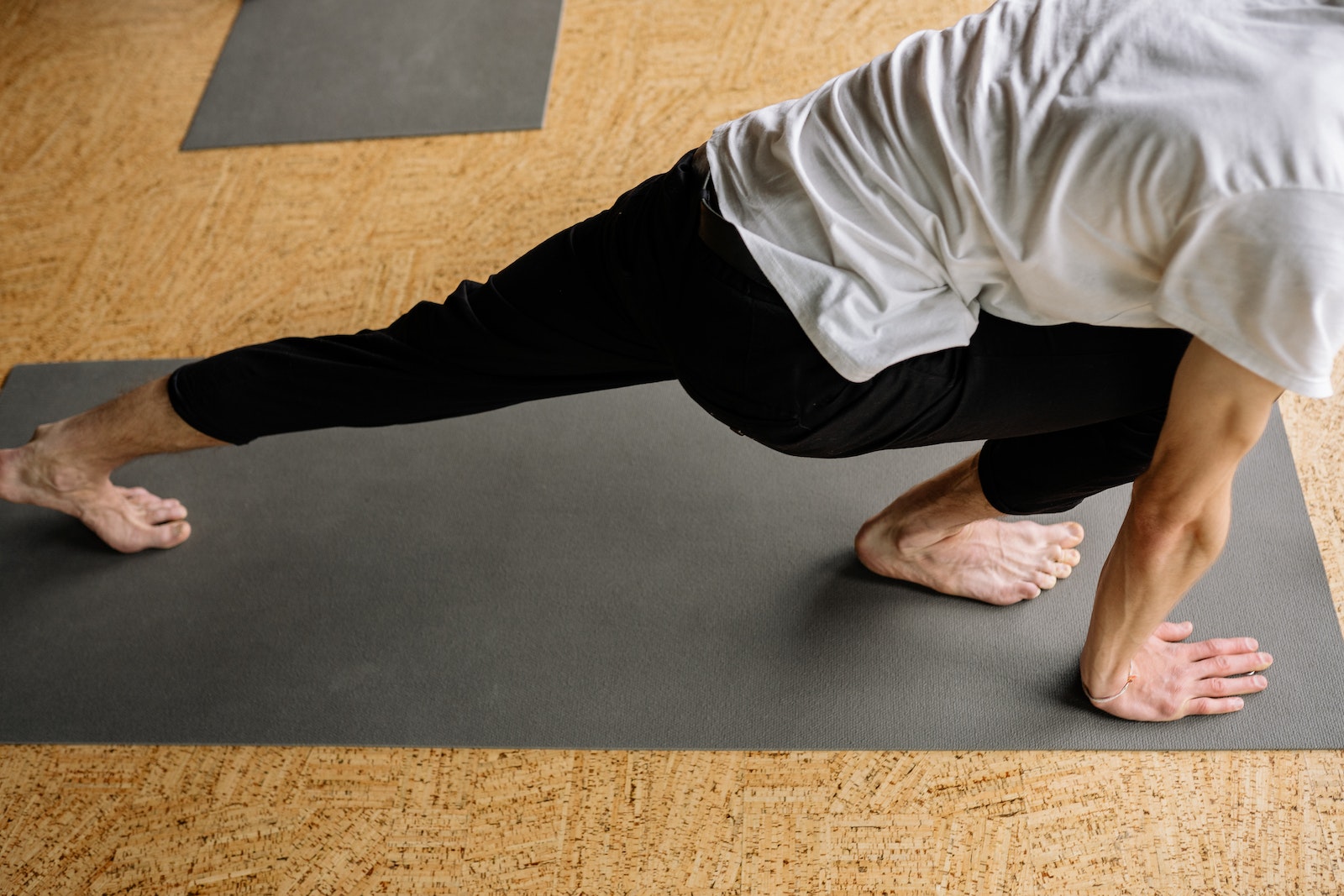Lunging into a lower body workout can leave you lamenting over knee pain if not done correctly. While lunges are an excellent exercise for strengthening your legs and stabilizing the hip and knee joints, improper form or muscle imbalances may lead to discomfort or even injury.
But don’t let the fear of knee pain hold you back from embracing the benefits of lunges in your fitness routine. In this article, we’re going to explore various causes of knee pain during lunges and provide valuable tips on how to lunge effectively without putting undue stress on your knees.
You’ll learn about proper technique, weight distribution, and alignment that can help alleviate potential knee pain while performing lunges. Additionally, we’ll discuss alternative exercises that can strengthen your knees and provide relief from existing discomfort.
By incorporating these tips into your workout regimen, you’ll be well on your way to building stronger knees with lunges – sans the pain! So get ready to conquer those lower body workouts and enjoy long-term relief by equipping yourself with the knowledge needed for safe and effective practice.
Table of Contents
Key Takeaways
- Knee pain during lunges can be caused by improper form, muscle imbalance, and weak hip and glute muscles.
- Exercises such as static lunges, modified bridge exercise, and clamshell exercises can help address knee pain during lunges by working inner thighs, glutes, and hip muscles.
- Seeing a physical therapist is recommended if knee pain persists, and modifications such as static lunges are better for those with balance issues.
- Proper form is key to getting the most out of the exercise and avoiding joint stress, and exercises such as glute bridge, chair squats, step ups, and high knee walks can help improve lunge technique and reduce knee pain.
Understanding Knee Pain and the Benefits of Lunges
So you’re experiencing knee pain during lunges, but did you know that with the right form and exercises, lunges can actually help strengthen your knees and alleviate discomfort? Understanding the causes of knee pain during lunges is crucial for prevention and effective therapy.
Some common factors contributing to discomfort include improper form, muscle imbalances, weakness in hip abductor and rotator muscles, as well as individual anatomy differences. To prevent knee pain during lunges, it’s essential to focus on targeted exercises that address these issues.
Strengthening your inner thighs, glutes, hips, and core muscles will provide better support for your knees. Additionally, incorporating stretching routines for quadriceps and hamstring muscles can improve flexibility and reduce strain on the joint. In some cases where anatomy plays a significant role in causing discomfort or misalignment during lunges, seeking professional guidance from a physical therapist might be necessary to identify personalized solutions tailored to your body’s unique needs.
As you work on strengthening your lower body muscles and improving flexibility through targeted exercises, it’s important to practice proper form during lunges themselves. Ensuring that your weight is distributed evenly over your heel while keeping your knee aligned with toes will help prevent unnecessary compression behind the kneecap or other potential injuries.
By focusing on good technique when performing this versatile exercise routine, not only can you alleviate existing knee pain but also create a strong foundation for future workouts. Now, let’s dive into how to maintain proper form for lunges so that you can avoid injury while maximizing their benefits.

Proper Form for Lunges to Avoid Injury
It’s crucial to nail down the proper form for lunges to avoid injury, and by doing so, you’ll be killing two birds with one stone – preventing pain and reaping the benefits of this effective exercise. Lunge technique plays a significant role in ensuring joint alignment, muscle activation, balance training, and injury prevention.
To achieve proper lunge form:
- Stand tall with feet hip-width apart
- Take a step forward or backward while maintaining balance
- Lower your body until both knees are bent at 90-degree angles
Focusing on joint alignment is essential when performing lunges. Make sure that your front knee is directly above your ankle, not pushed out too far. Your back knee should hover just above the floor without touching it. Keep your core engaged throughout the movement for added stability and ensure that your upper body remains upright during the entire exercise.
As you become more comfortable with lunges, incorporate muscle activation techniques such as squeezing your glutes when pushing back up to the standing position. This will help strengthen these muscles while also promoting better balance during the movement. Balance training can be further enhanced by holding onto a wall or chair for support if needed until you’ve built up enough strength and confidence to perform lunges unassisted.
Now that you have an understanding of how to execute proper lunge technique, let’s explore modifications for those experiencing knee pain or limitations during this beneficial exercise.
Modifications for Lunges with Knee Pain or Limitations
When dealing with knee pain or limitations, you can still benefit from lunges by trying out some modifications that’ll suit your needs better. Modified lunges help to alleviate pressure on the knees while still engaging and strengthening the necessary muscles for improved stability.
One cause of knee pain during lunges is tightness in the IT band, so make sure to incorporate IT band foam rolling into your routine to keep it loose and flexible.
Another modification worth considering is split squats. These exercises are a great alternative to traditional lunges as they require less dynamic movement and place less stress on the knees when performed correctly. Just like with modified lunges, proper form is crucial to ensure you’re targeting the right muscles without putting unnecessary strain on your joints.
Additionally, if you experience discomfort due to flat feet or overpronation, arch supports can provide extra stability and prevent further knee pain during these exercises.
Remember that everyone’s body is different, so finding a lunge variation that works best for you may require some trial and error. Be patient with yourself as you explore different options and focus on perfecting your form in each exercise.
As you continue working on these modified lunges and split squats, along with using helpful tools like foam rolling or arch supports as needed, you’ll build stronger knees while minimizing discomfort.
Now let’s move onto additional exercises that will further strengthen your knees and improve overall joint health!

Additional Exercises to Strengthen Your Knees
Imagine feeling like a superhero, effortlessly gliding through your workouts with strong and pain-free knees – that’s the power of incorporating additional exercises into your routine to support joint health.
One effective exercise to consider is the single leg squat, which targets the same muscles as lunges while providing additional stability for your knees. Additionally, using a leg press machine can help you build lower body strength in a controlled environment, allowing you to focus on proper form and prevent any unnecessary strain on your joints.
Incorporating arch supports or orthotics into your footwear can also provide added comfort and stability during exercises like lunges and squats. This extra support helps evenly distribute weight across your feet, reducing stress on your knees and promoting better overall alignment.
If you’re still experiencing knee pain despite these modifications, it might be time to consult with a physical therapist who can assess your individual needs and design a personalized program for long-term relief.
Remember that consistency is key when it comes to strengthening your knees. By regularly incorporating lunges along with other supportive exercises like single leg squats and leg presses into your fitness routine, you’ll be well on your way towards healthier joints and improved overall performance. So go ahead – embrace the power of strong knees by integrating these tips into your workout regimen today!
Now let’s dive deeper into how incorporating lunges into your fitness routine can provide long-term relief from knee pain.
Incorporating Lunges into Your Fitness Routine for Long-Term Relief
You’ll feel unstoppable as you incorporate lunges into your fitness routine, paving the way for long-term relief from knee pain and a newfound sense of confidence in your daily activities. The benefits of lunges are numerous, with improved muscle activation and strength being at the top of the list.
To get started, focus on these three key aspects:
- Proper form and technique
- Gradual progression and variety
- Pre- and post-workout stretching techniques
Paying close attention to proper form is crucial in order to reap the full benefits of lunges without causing further injury or strain on your knees. Some common mistakes include not bending your front knee to a 90-degree angle, having too narrow of a stance, or placing improper weight distribution through your feet. To avoid these pitfalls, make sure to keep your chest lifted, shoulders back, and core engaged while maintaining alignment between your knee and toes throughout the movement.
As you become more comfortable with basic lunges, consider adding variety through different lunge variations such as reverse lunges, side lunges, or even walking lunges for an added challenge that targets multiple muscle groups in various ways. Gradual progression is important for building strength while minimizing risk; start by performing bodyweight lunges before slowly incorporating weights or increasing repetitions over time.
Additionally, don’t forget to incorporate pre- and post-workout stretching techniques that target surrounding muscles like quadriceps, hamstrings, hips flexors – this will help improve mobility around the knee joint while reducing any lingering discomfort after training sessions.
By keeping these tips in mind when incorporating lunges into your fitness routine, you’ll find yourself experiencing less knee pain while enjoying increased strength and stability in both legs – helping you feel more confident as you tackle everyday activities with ease!

Conclusion
So, you thought lunges were just a cruel joke to make your legs burn? Turns out, they’re actually a powerful tool for strengthening those knees and keeping them pain-free. Who would’ve thought?
Don’t let knee pain hold you back from mastering the lunge game. By focusing on proper form, making modifications when needed, and incorporating additional exercises into your routine, you’ll be lunging like a pro in no time — and with happy knees, too!
Frequently Asked Questions
How long does it typically take to see improvements in knee strength and stability after incorporating lunges into a fitness routine?
It’s tough to pinpoint exactly when you’ll notice improvements in knee strength and stability after adding lunges to your routine. Remember, knee-friendly alternatives, proper form, lunge variations, balance exercises, and post-lunge recovery are crucial for success. Keep at it!
Are there any specific warm-up exercises or stretches recommended before performing lunges to minimize the risk of knee pain?
Before lunging, try knee-friendly alternatives like single leg balances and step-ups. Identify pain triggers and adjust your lunge technique accordingly. Warm up with dynamic stretches and consider supportive gear options.
How can I progress safely with lunges if I currently experience knee pain during the exercise?
To progress safely with lunges, identify pain triggers and follow proper form guidance. Try knee-friendly alternatives like modified lunges or step-ups. Explore lunge variations and consider joint supplements for extra support.
Are there any specific footwear recommendations for those with knee pain when performing lunges?
Footwear’s fundamental for fending off knee pain during lunges. Opt for shoes with solid support and cushioning. Knee-friendly alternatives, lunge variations, joint supplements, and maintaining proper form can also contribute to comfort.
How often should lunges be incorporated into a fitness routine for optimal knee strengthening and pain relief benefits?
Incorporate lunge variations into your fitness routine 2-3 times per week for optimal knee strengthening. Start with beginner modifications and explore lunge alternatives if needed. Prioritize post-lunge recovery and avoid common lunge mistakes.



